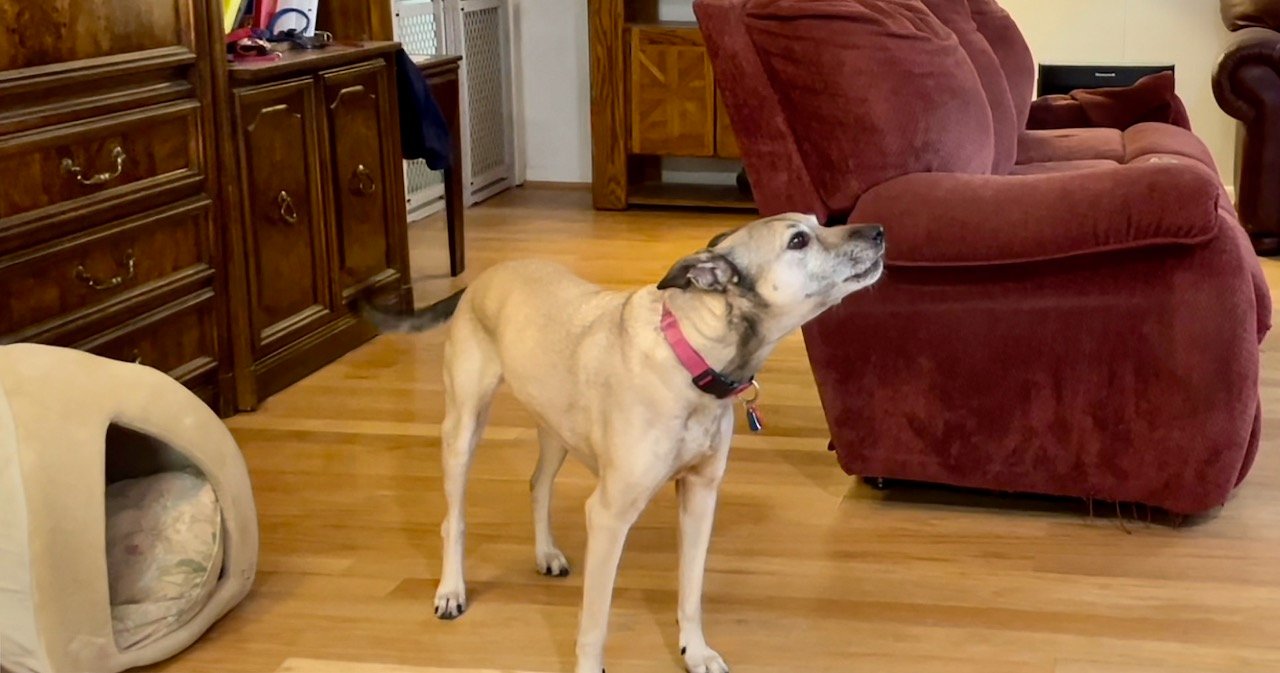

Clara has never barked much. She rarely joins into social barking with other dogs, partly because I taught her when young to come to me instead. She doesn’t bark for my attention or from excitement. She doesn’t demand bark for meals or toys. She doesn’t even bark to be let in or out doors. The only barking she does much of is alarm barking. For instance, she’ll bark at some neighbors or their dogs when she’s in the yard. But even with that barking, she’s not persistent.
Although I have influenced her behavior with training over the years, it’s not all me. In a lot of ways, she’s a low energy dog, and I think she’s naturally not much of a barker.
Until now.
Is It a Symptom?
For about a month now, Clara has been barking. Frequent sessions of solo barking. Up to 15 times a day. And the way she does it seems—not normal.
She always starts the same way. She stands in one of about four preferred places. She looks off into space for a while. Then she starts quietly huffing. Over a few seconds, this develops into full-throated barking. She will then bark for several minutes. If not interrupted, she will simmer down after a while, then start anew a minute or two later.
Changed vocalization can be a symptom of canine cognitive dysfunction (CCD).
Yes, lightning may have struck twice with my dogs. Many of you know that my rat terrier Cricket had CCD, and I wrote a book about it.
Cricket’s barking behavior changed because of CCD, but it was in the other direction. She had always been a noisy little dog, particularly with excitement and demand barking. She got quieter and quieter as her cognitive dysfunction progressed, and finally stopped barking at all.
What Am I Doing about It?
- I immediately started taking notes and recording video
- I scheduled a vet visit
- I started planning for the possible challenges ahead
When the barking started (my first note is from November 22, 2023), Clara was due for her yearly vet exam. So the new vocals made me get up off my butt and schedule her visit. We saw the vet a week later.
We discussed the behavior and went over other possible symptoms, of which Clara appears to have none. The vet did senior dog blood work, which came out “perfect.” She checked Clara carefully for pain. Clara is 12 1/2 years old and medium-sized, and it would be normal for her to have joint pain. The vet couldn’t find any, though, and that fit with my observations as well.
Clara is not currently diagnosed with canine cognitive dysfunction. But the vet and I agreed on trying some meds, since early intervention is better than late.
I mentioned above that I started taking notes. I have an app I use as a dog diary. I’ve been tracking barking frequency, duration, time of day, and any other factors I can identify. This helps me be able to see changes more clearly, and will help me track her responses to meds.
I’m thinking ahead about training and husbandry. Clara is losing her hearing (more on that below), so I need to be working on visual and tactile markers. She may need to wear diapers at some point; the time to get her used to them is now. Ditto with her “Help ‘Em Up” harness. Leg weakness is not a symptom of CCD to my knowledge, but it’s common with senior dogs. If she needs mobility help in the future, it’s better to introduce the harness now while she can learn things normally.
Barking Video
Here are a couple of scenes of Clara and her new barking habit.
In the video, near the beginning of the barking, Clara looks at me and lingers in that position. But I don’t think the barking is a bid for connection. That look is because she noticed the camera. When I call her shortly after that, I have to call twice. That may be because she is “in the zone” or because of her currently mild hearing loss.
Another interesting thing you can see is Lewis’ response, or non-response. Lewis is really into his vocals. If another dog barks, he’s right up in their business, barking in tandem, pushing past them, and sometimes redirecting if there is something exciting to see or get to. But in this case, he stays quietly next to me on the couch. He looks a bit concerned, perhaps. But I feel like his reading of Clara’s barking is the doggie corollary to my own, that Clara’s behavior is not in response to any of the usual barking triggers dogs share. It’s not something that prompts him to take action. That’s a rarity.
Antecedents and Consequences
As someone who helps her dogs and her household via training, of course I considered whether I could or should intervene in this behavior. I’m still trying to determine whether Clara is distressed. Most of the time, I don’t think so.
Is it hard for the rest of the household? Yes.
I’ve identified clear antecedents. I know what’s going on in the environment whenever she does this: not much for dogs.
Like any household, we have our routines, and the dogs know them cold. They know when periods come along in which it’s up to them to entertain themselves. These periods happen when three things are true: no food is soon to be available for dogs; they’ve already been outside a while; and I sit down either to eat or to work.
Clara’s behavior for many years has been to curl up in a chair and go to sleep during this downtime. Once in a while, she’ll still entertain herself by chewing something. But for the last few weeks, she goes instead to one of her Barking Places and tunes up to bark. We could say she’s bored and at loose ends; that’s probably true. But the house routines haven’t changed. Those periods of boredom were always there. What’s changed is her response to them.
Should I intervene? She rarely seems agitated. She is barking into the ether rather than curled up somewhere. Maybe she’s OK with that. If she is, any intervention will be on behalf of the humans. Because look at the antecedents: she barks whenever I sit down to work or enjoy a meal. Gotta admit, that’s hard on me. Having your dog stand 10 feet away from you loudly barking is a strong aversive stimulus. My whole body says that I need to take action.


I may or may not do something out of my personal frustration. But if my read on it is that Clara is distressed, I try to comfort her, or my partner does. If we reinforce the barking, that’s just the way it is. I will not leave my beloved senior dog asking for something and not getting it. If indeed she is asking. And if indeed I can help.
So many questions.
If the behavior is driven by cognitive dysfunction, the result of wires crossed in her head, it may not be reinforceable anyway.
Here are some of the things I do:
- Change the environment. I may get up and walk to the back of the house or go check the mail or do some dishes. The simple action of me moving around will interrupt her for a time. She may come along or watch.
- Take all the dogs outside. This gives her a change of scenery and some stimulation.
- Preemptively pass out food toys when down time approaches.
- Sit down on the couch with her. She loves this and will usually settle down.
- Take her back to my bedroom and sit on the bed. This is her very favorite, her happy place.
Note that all the above are incompatible with me eating, and the first two are incompatible with working. But also: her pleased response to those last two may mean she is distressed after all. I’m still working on figuring that out. Clara is well into the old doggie, “Whatever you want, dear” period. I’ll do whatever I can to keep her comfortable and happy.
Looking Back
In retrospect, has she shown other symptoms? What about her trauma response a year ago? Or the humming and mumbling she started doing further back than that?
With Cricket, I only realized she had a particular symptom (so-called “changed social interactions”) a year after it had been going on. I didn’t know about CCD then, so didn’t know the possible significance of her drawing away from my partner, whom she had always loved.
So when Clara’s behavior changed, my mind started churning forward and backward—forward to worry about future challenges and heartache, and backward to see if I could think of any other telltale signs. Her apparently over-the-top response to slipping when getting out of the car a year ago could have been an early symptom, falling under the category of increased fear/anxiety.
This is speculation. But that response was unlike anything I’d ever seen from her before. I’m not attached to the idea in a big way, but it’s something to keep in mind.
I don’t think her mumbles, sighs, and hums are related to possible CCD; they started around the time of her Cushing’s diagnosis. But they could be—they are also vocalizations.
Risk Factors
Clara has three possible risk factors for CCD. One of them is, of course, her age. There are several studies that provide powerful evidence for this. One study of 180 senior dogs found that 28 percent of those 11 to 12 years of age showed signs of at least one type or category of impairment linked to cognitive dysfunction (Neilson et al., 2001). Clara is now 12 1/2. More recently, the Dog Aging Project found in a study of more than 15,000 dogs that when looking at age alone and no other factors, the likelihood of being diagnosed with CCD increased by 68% each year of a dog’s life after age 10 (Yarborough et al., 2022).


That’s tough enough to consider. But Clara may have other risk factors as well.
She has Cushing’s disease, and there is one research paper that found a correlation between Cushing’s syndrome and the likelihood of CCD (da Silva et al., 2021). (Cushing’s disease is a specific type of Cushing’s syndrome.) The study surveyed 57 dog guardians, 19 of whose dogs had Cushing’s syndrome and 38 of whose did not. The guardians were questioned about their dogs’ cognition and CCD symptoms. The dogs with Cushing’s exhibited a higher final score of cognitive dysfunction than the control dogs, including higher memory difficulties, more compulsive behaviors, and more depressive behaviors and anxiety.
Finally, Clara is also losing her hearing. Another paper recently found pretty strong correlations between hearing loss in senior dogs and CCD (Fefer et al., 2022). Not only was there a correlation between the two, but the level of hearing loss correlated with the amount of cognitive dysfunction.
Both of these latter two are initial studies, not yet replicated. But damn.
Planning, Denial, Hope


My inner world is in conflict. On the one hand, I have sprung into action; planning for certain eventualities if Clara has dementia. I get cerebral and ultra-rational when I get shocking news. I throw myself into planning.
On the other hand, it hasn’t sunk in emotionally yet. Except for this one behavior, she seems normal and clever, her usual self.
I’ve got either denial or some version of carpe diem. Or it could be that fickle friend: hope. Maybe there is no decline going on. But I suspect there is.
A Resource
If you are concerned that your own dog may have canine cognitive dysfunction, talk to your vet. You may also want to visit my website that is dedicated to that condition: dogdementia.com. You can download my checklist of possible symptoms to fill out and take to your vet.
References
da Silva, C. C., Cavalcante, I., de Carvalho, G. L. C., & Pöppl, Á. G. (2021). Cognitive dysfunction severity evaluation in dogs with naturally-occurring Cushing’s syndrome: A matched case-control study. Journal of Veterinary Behavior, 46, 74–78.
Fefer, G., Khan, M. Z., Panek, W. K., Case, B., Gruen, M. E., & Olby, N. J. (2022). Relationship between hearing, cognitive function, and quality of life in aging companion dogs. Journal of Veterinary Internal Medicine, 36(5), 1708-1718.
Neilson, J. C., Hart, B.L., Cliff, K. D., & Ruehl, W. W. (2001). Prevalence of Behavioral Changes Associated with Age-Related Cognitive Impairment in Dogs. Journal of the American Veterinary Medical Association, 218 (11), 1787–1791.
Yarborough, S., Fitzpatrick, A., & Schwartz, S. M. (2022). Evaluation of cognitive function in the Dog Aging Project: associations with baseline canine characteristics. Scientific Reports, 12(1), 13316.
Copyright 2023 Eileen Anderson






